
Space-rockets with spreadable-arms invented by Roman Nawojczyk
And the SYSTEM for these space-rockets equipped with spreadable-arms.
Below are shown 50 pages with the drawings from my patent applications.
These pages are in the 40% picture resolutions with descriptions.

|
FIG.4, 5, 6 are the views which show space-rockets launch method in the system for multiple use of several space-rockets equipped with several spreadable-arms 5. Here are shown the multi-task station for three jointed space-rockets launch preparation, liftoff and later unloading from the specific sea ship 10. It is recommended that this multi-task station would be at a sea harbor wharf so that it could be possible to reload the space rockets from any specific sea ship. The multi-task station comprises two movable ground-gantries 104 and one movable specific ground-crane 105. Therefor currently three joined space-rockets hang on all their spreadable-arms 5 on two movable ground-gantries 104 and will liftoff this way. |
|
These three joined space-rockets are one main-rocket 2 which is joined on both sides with two booster-rockets 1. On the main-rocket 2 top it is mounted the assemblage which consist of the second-stage-rocket 3 with attached the sectional-load-cover 4. And on this FIG.4 is also sketched the side drawing of one movable specific ground-crane 105, because it earlier moved away. FIG.7 is the side view of three joined space-rockets which are awhile after the liftoff and the side view of two movable ground-gantries 104 which are spread somewhat apart on two sides. |

|
FIG.8 is a prospectus presentation which shows many crowd scenes in the system for multiple use of several space-rockets equipped with several spreadable-arms 5. The current whole presentation shows the methods of three joined space-rockets launch and entire process ascent toward the Earth's orbit, descent and vertical landing with return-load according to current invention. Therefor this FIG.8 shows for example plurality drawing statuses of three joined space-rockets with their liftoff, joined ascent, their separation, further separated ascent toward the Earth's orbit, deploy a payload, dock a return-load, and their individual descending and vertical landing aboard the specific sea ship 10 at open sea. On all rocket statuses and alongside the arrows show the directions of their traveling trajectories. These three joined space-rockets are the same as on previous FIG.4, 5, 6, 7 and further FIG.268, 269 and these are one main-rocket 2 which is joined on both sides with two booster-rockets 1. |
|
On the main-rocket 2 top it is mounted the assemblage which consist of the second-stage-rocket 3 with attached the sectional-load-cover 4. At beginning these three rockets statuses are in two front drawings. Thereafter all rockets statuses are in the side drawings and show their travel toward the specific sea ship 10 which is in the side drawing as well. Here alongside the rocket drawing statuses are the numbers in some small circles which explain the rockets landing sequences. Descent process from the Earth's orbit individually by three space-rockets will end with vertical landing aboard the specific sea ship 10. Therefor both movable ship-gantries 20 are entirely spread apart in two directions before landing of every space-rocket as it is shown on current view. The entire prospectus presentation on FIG.8 targets presentation that is possible individual, vertical landing as many as three space-rockets equipped with spreadable-arms 5 on one specific sea ship 10 at sea. . |

|
FIG.1, 2, 3 show space-rockets vertical landing method in the system for multiple use of several space-rockets equipped with several spreadable-arms 5. Here is shown the method of three space-rockets vertical landing on the specific sea ship 10 with deck-mounted landing-station having four hangers 24, two grasping-wagons 44, two movable ship-gantries 20 with several damping-wagons 30 or 31 whereon each rocket vertically lands as hangs itself on its spreadable-arms 5. On landing-station can land three space-rockets in a few minutes intervals. Two first can be quick moved on hangers and fasten. The third landed rocket remains on both movable ship-gantries and is fastened by both grasping-wagons. |
|
The current views show just vertically landing one booster-rocket 1 with entirely lifted (spread out) all spreadable-arms 5. The FIG.1 shows additionally an enlarged fragment with the damping-wagon 30 and the second enlarged fragment of the booster-rocket 1 upper part showing the spreadable-arms 5 and a few steering flaps 6. Furthermore nearby to specific sea ship 10, current FIG.1 shows the second booster-rocket 1 and a main-rocket 2 which both have also entirely lifted (spread out) all their spreadable-arms 5. This view shows and explains that on the same specific sea ship 10 with such landing-station can still additionally vertically land these two earlier mentioned space-rockets. |

|
FIG.9, 10 are the views which show rockets vertical unloading method in the system for multiple use of several space-rockets equipped with several spreadable-arms 5. Here is shown the method of three space-rockets vertical unloading from the specific sea ship 10 at multi-task station according to current invention. Therefor these views shows the specific sea ship 10 which just moored at multi-task station for unloading of three space-rockets which later can be launch again together or individually. |
|
This multi-task station consists of two movable ground-gantries 104 and of one movable specific ground-crane 105. Aboard the specific sea ship 10 are hanged and still individually fastened three space-rockets. This view targets presentation that construction of such multi-task station is very simple and very well fitted for taking delivery of the rockets from the specific sea ship 10 after hers arriving to this multi-task station. . . |
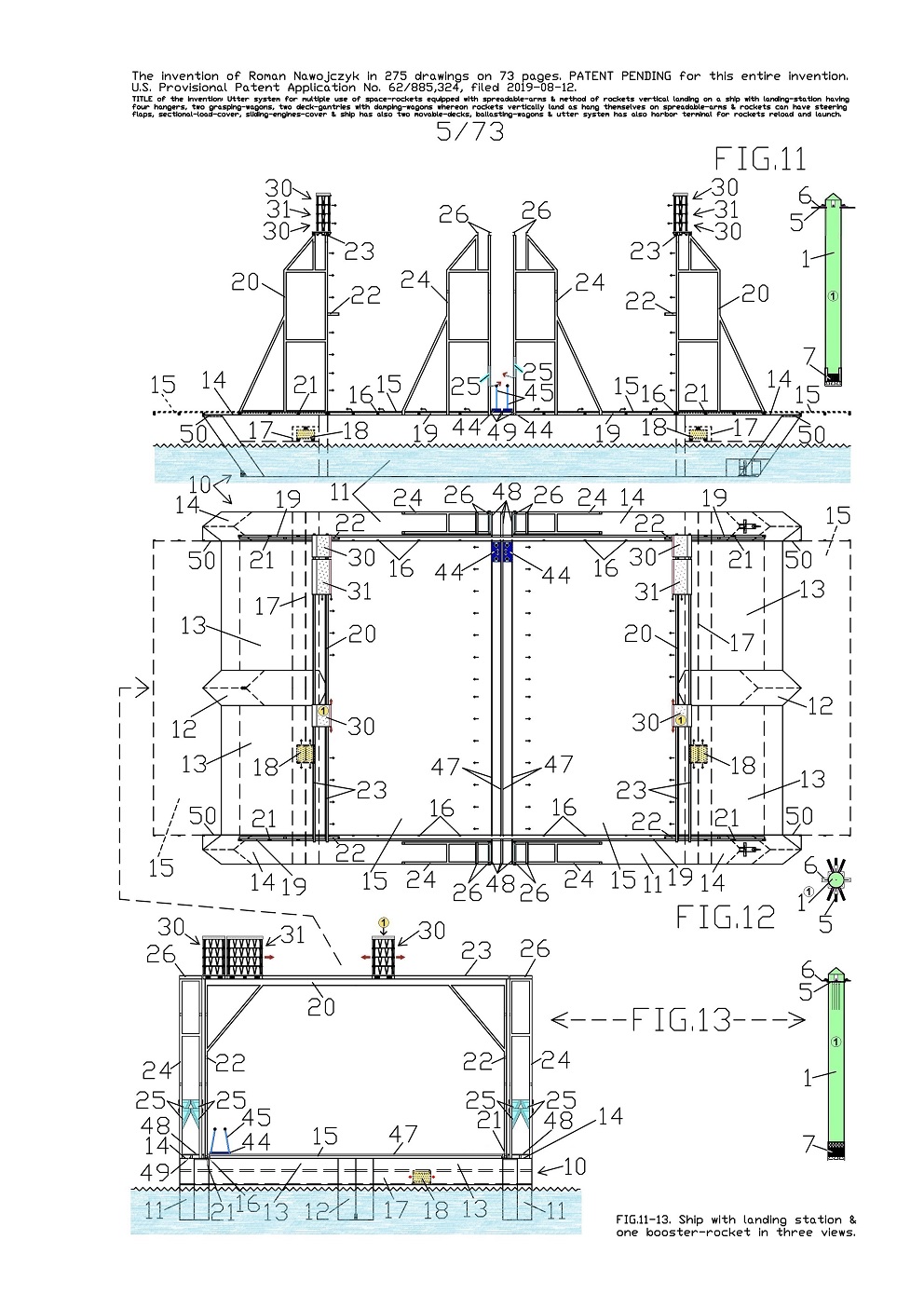
|
FIG.11, 12, 13 show three views of the entire specific sea ship 10 which has deck-mounted landing-station for individual, vertical landing and also for remotely-controlled fastening of three space-rockets equipped with several spreadable-arms 5. Therefor nearby the specific sea ship 10 is also one booster-rocket 1 which has entirely lifted (spread out) all spreadable-arms 5. The views show the specific sea ship 10 and the landing-station ready for landing the first booster-rocket 1. |
|
These two ballasting-wagons 18 are placed in two tunnels 17 which are transverse to specific sea ship 10 multi-hull. Whereat in these two tunnels 17, both ballasting-wagons 18 are currently shifted into such side-setting which maintains exactly horizontal position of the specific sea ship 10. Whereas the right places for setting all damping-wagons on both movable ship-gantries 20 tops are selected in such way which enable carrying out individual landing of three space-rockets. |

|
FIG.14, 15, 16 show three views of the entire specific sea ship 10 which has deck-mounted landing-station for individual, vertical landing and also for remotely-controlled fastening of three space-rockets equipped with several spreadable-arms 5. |
|
This booster-rocket 1 earlier landed and furthermore it is still fastened also at bottom by means of four rotating-poles 45 which reach from two grasping-wagons 44. |

|
FIG.17, 18, 19 show three views of the entire specific sea ship 10 which has deck-mounted landing-station for individual, vertical landing and also for remotely-controlled fastening of three space-rockets equipped with several spreadable-arms 5. |
|
These two rockets earlier landed and currently the views show this specific sea ship 10 and the landing-station ready for landing the third space-rocket which will be the main-rocket 2. |

|
FIG.20, 21, 22 show three views of the entire specific sea ship 10 which has deck-mounted landing-station for individual, vertical landing and also for fastening of three space-rockets equipped with several spreadable-arms 5. |
|
After the main-rocket 2 hanging itself, both large damping-wagons 31 became entirely compressed and which is well visible on FIG.20 and 22. Presented here the specific sea ship 10 with landing-station having strong fastening of the rockets enables sea-transportation even at stormy sea. Whereat in two tunnels 17, both ballasting-wagons 18 serve also for automatic, continuous, quick and precise ballasting of this specific sea ship 10 during seafaring. . |

|
FIG.23, 24, 25 show three views of the alone entire landing-station for individual, vertical landing of three space-rockets. |
|
Each hanger 24 has two rotating-wedges 25 which serve for remotely-controlled fastenings of one space-rocket. One par of hangers 24 serve for hanging one space-rocket and fastening it by means of four rotating-wedges 25. On each hanger 24 top are two upper-short-rails 26. Whereas on each movable ship-gantry 20 top are two upper-long-rails 23. Therefor on both movable ship-gantries 20 tops are together four upper-long-rails 23 whereon stand four damping-wagons 30 and two large damping-wagons 31. Both movable ship-gantries 20 can separably roll along the entire specific sea ship 10 on two deck-rails 19. For rolling both movable ship-gantries 20 use their own plurality wheels 21. |

|
FIG.26, 27, 28 show three views of two whole movable ship-gantries 20 by themselves which are in the same arrangement like aboard the specific sea ship 10 and the same as on FIG.1, 2, 3 and 11, 12, 13. |
|
Therefor each movable ship-gantry 20 can roll until direction of the opposite movable ship-gantry 20, if necessary during landing of some space-rocket. It causes that each space-rocket can land almost on entire length of the specific sea ship 10. While on all drawings there are shown only landings examples in the ship center. . |

|
FIG.32, 33, 34 show three enlarged views of one pair of hangers 24 wherein each has two rotating-wedges 25 lowered and with the arrows showing their rotating directions. Each rotating-wedge 25 has its own rotary-actuator 27.Whereas FIG.32 is the side view, FIG.33 is the top view, FIG.34 is the front view. |
|
FIG.35, 36, 37 show the enlarged views of one pair of hangers 24 with the rocket-fuselage 51 fragment which is fastened by means of four rotating-wedges 25. These four rotating-wedges 25 are rotated in such way that they all together tighten up this rocket-fuselage 51 fragment.Whereas FIG.35 is the side view, FIG.36 is the top view, FIG.37 is the front view. |

|
FIG.39, 40, 41 show three enlarged views of one pair of hangers 24 whereon tops in the upper-short-rails 26 stand two damping-wagons 30. These two damping-wagons 30 are not compressed because they are not loaded with any rocket. |
|
Simultaneously the booster-rocket 1 in its bottom is fastened by means of four rotating-wedges 25. |

|
FIG.45, 46, 47 show three enlarged views of the rotating-wedges 25 with some hanger 24 fragments sketches which are performed with the dashed lines. All four rotating-wedges 25 are completely lowered and with the arrows showing their rotating directions. And FIG.45 is the side view, FIG.46 is the top view, FIG.47 is the front view. The opposite hangers 24 have the rotating-wedges 25 mounted on varied heights so that they would not hook each over. |
|
FIG.51 is the top view and shows for example the rocket bottom that is moved away from correct location. If some rocket accidentally hung up itself aslant then all rotating-wedges 25 will enable pushing this rocket to as best location as its possible in order to fasten this rocket. It shows this FIG.51 and here two upper rotating-wedges 25 are pushing this rocket bottom. . |

|
FIG.55, 56, 57 show three a lot enlarged views of one pair of hangers 24 upper part in the same statuses as were earlier shown on FIG.39, 40, 41. On the hangers 24 tops and on the upper-short-rails 26 stand two damping-wagons 30. These two damping-wagons 30 are not compressed because they are not loaded with any load. On both damping-wagons 30 tops are situated thick flexible-layers 32 which are marked with the dots on the views. Furthermore there are also permanently fastened flexible wedge-shaped-fenders 33 in the uppermost and bottom part of each damping-wagon 30. There are also visible all leading-shafts 34 in not compressed both damping-wagons 30. FIG.58, 59, 60 show three a lot enlarged views of one pair of hangers 24 upper part in the same statuses as were earlier shown on FIG.42, 43, 44. Here on one pair of hangers 24 is hanged one booster-rocket 1. All six spreadable-arms 5 of this one booster-rocket 1 lay on two damping-wagons 30 which are in fullness compressed by weight of this rocket. All six spreadable-arms 5 penetrated and couched on two thick flexible-layers 32 on both damping-wagons 30 tops. |
|
Furthermore there are also visible four flexible wedge-shaped-fenders 33 whereon is leaned against the booster-rocket 1 frame. . |
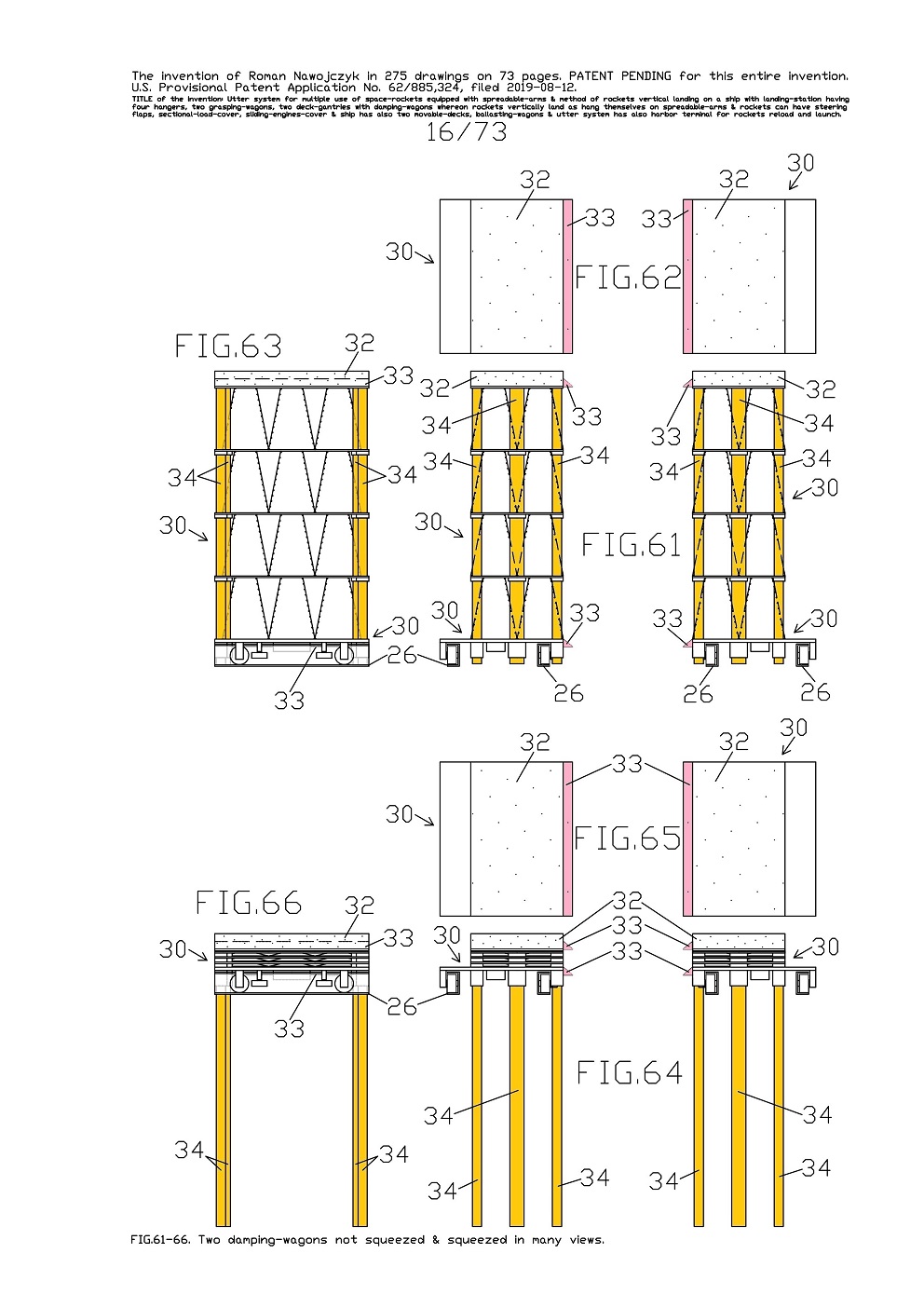
|
FIG.61, 62, 63 show three a lot enlarged views of two damping-wagons 30 which are not compressed and they stand on the upper-short-rails 26 which are on tops of one pair of hangers 24. These two damping-wagons 30 are in the same setting as on previous FIG.55, 56, 57. Here is visible construction of two damping-wagons 30 and their interrelationship because for one rocket hanging itself there are necessary suchlike two damping-wagons 30. |
|
FIG.64, 65, 66 show three a lot enlarged views of two damping-wagons 30 and which for example are compressed and stand on the upper-short-rails 26 which are on tops of one pair of hangers 24. These two damping-wagons 30 are in the same setting as on previous FIG.58, 59, 60. Here is also visible that compressed both damping-wagons 30 lowered their all leading-shafts 34. Here, except of the upper-short-rails 26 there are not other fragments of the hangers 24. |
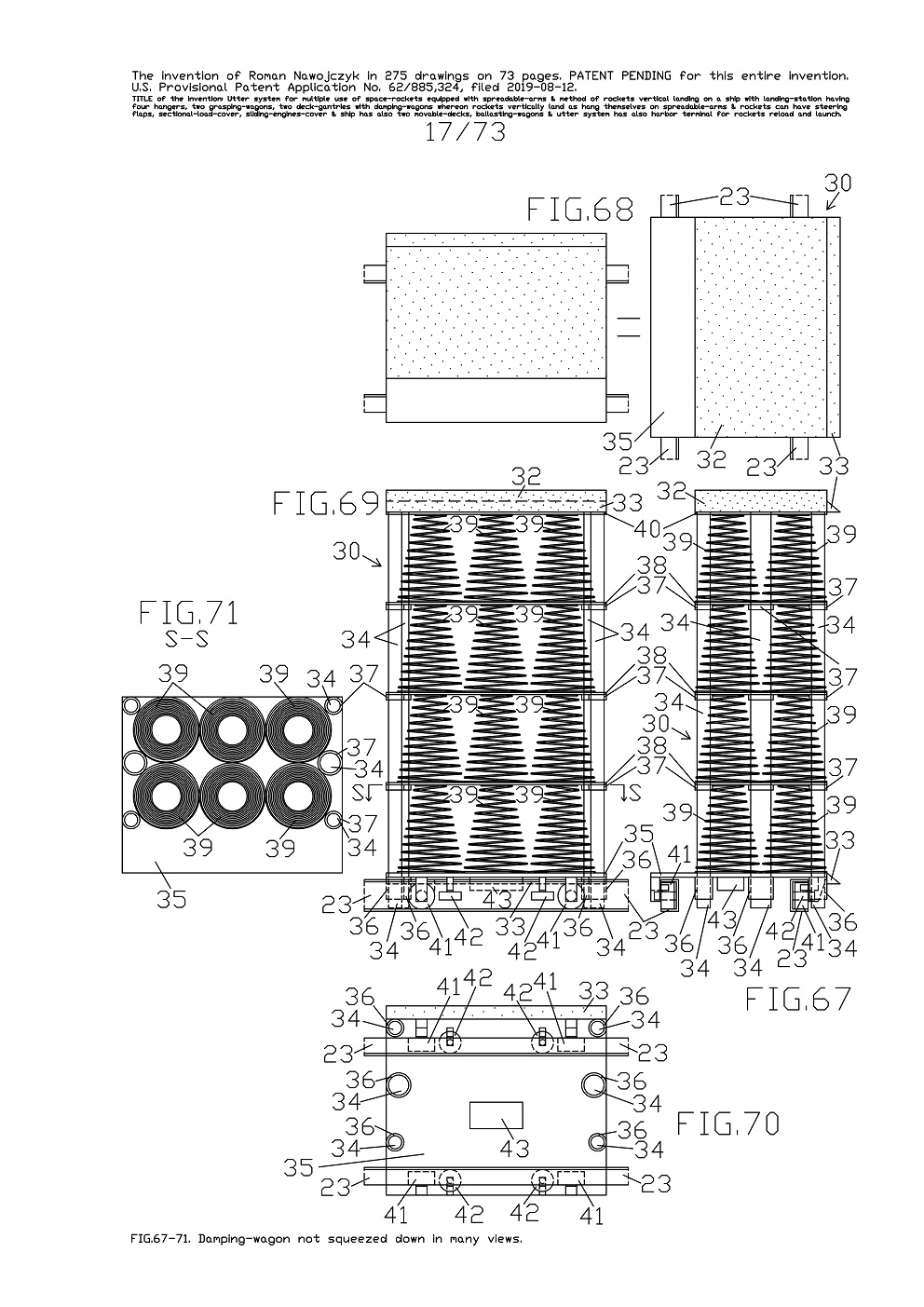
|
FIG.67, 68, 69, 70, 71 show several a lot enlarged views and the horizontal sectional view and a bottom projection of one entire damping-wagon 30 which is not compressed and in different manner than previously, stands on two upper-long-rails 23 which are on one movable ship-gantry 20 top. Whereas FIG.67 is the side view, FIG.68 is the top view in two equal views which are rotated 90 degrees in relation to each other so that they cohere with the below views. And FIG.69 is the front view, FIG.70 is the bottom projection. And FIG.71 is the top view of the horizontal sectional view according to S-S line on FIG.69. There are visible all sub-assemblies and construction of one damping-wagon 30. |
|
This top-plate 40 has on both sides permanently fastened six leading-shafts 34 which are spaced out suitably to being situated under them the low-leading-tubes 37 in all middle-plates 38 and all high-leading-tubes 36 in the main-plate 35. |

|
FIG.72, 73, 74 show three a lot enlarged views of one entire damping-wagon 30 and which for example is compressed and does not stand on any rails. Whereas FIG.72 is the side view. And FIG.73 is the top view of one damping-wagon 30 in two equal views which are rotated 90 degrees in relation to each other so that they cohere with the below views. And FIG.74 is the front view. Here is visible that all conic-springs 39 are entirely compressed. Whereat all conic-springs 39 in the highest layer are perfectly entirely compressed. |
|
Whereat all conic-springs 39 in the lower three layers are compressed to low-leading-tubes 37 height. Here is also visible that all leading-shafts 34 over-passed all low-leading-tubes 37 and all high-leading-tubes 36. As result all leading-shafts 34 are hanging by themselves down under the damping-wagon 30. This solution of the leading-shafts 34 which are fitted with all leading tubes creates damping high range and simultaneously maintains unshaken and stable top surface of all damping-wagons during compressing by rocket. |

|
FIG.80, 81, 82 show three views of two grasping-wagons 44 wherein each with two rotating-poles 45. These two grasping-wagons 44 stand on four short-transverse-rails 48. The current views show the rotating-poles 45 lifted to setting similar as during holding the space-rocket. Whereat the sketches of two right rotating-poles 45 together with the arrows show their total possible rotation range. |
|
Both grasping-wagons 44 wherein each has two rotating-poles 45 with spherical ends which have flexible coatings. These flexible coatings are intended for direct contacts with the space-rockets. |

|
FIG.86A, B and FIG.87 and FIG.88A, B show three views of one booster-rocket 1 upper and bottom parts which has six spreadable-arms 5, four steering flaps 6 and one sliding-engines-cover 7. |
|
Here all spreadable-arms 5 are entirely lowered and consequently are alongside the rocket frame. |

|
FIG.89A, B and FIG.90 show two views of one booster-rocket 1 upper and bottom parts which has a little lifted all six spreadable-arms 5 and consequently they a little protrude outside the rocket frame. Whereat all four flaps 6 are a lot deflected out and consequently protrude outside the rocket frame. Whereat the sliding-engines-cover 7 is entirely lifted. |
|
Whereas FIG.89A is the side view of one booster-rocket 1 upper part. And FIG.89B is the side view of one booster-rocket 1 bottom part. And FIG.90 is the top view of FIG.89A, B in the same arrangement and situation. On FIG.89A, B the arrows show the spreading directions of the spreadable-arms 5 and deflection of the flaps 6. On FIG.89A, B, on the rocket frame are clearly visible several corner-beams 52 which lead sliders 53 of the spreadable-arms 5. |

|
FIG.91A, B and FIG.92 and FIG.93A, B show three views of one booster-rocket 1 upper and bottom parts. This booster-rocket 1 has entirely lifted all six spreadable-arms 5 and consequently they are completely spread out on two sides. And therefor these spreadable-arms 5 are transverse the rocket frame. |
|
Whereat the sliding-engines-cover 7 is entirely lifted and it uncovered all nozzles of the main engines. |

|
FIG.94A, B and FIG.95 and FIG.96A, B show three views of one main-rocket 2 upper and bottom parts which has ten spreadable-arms 5, four steering flaps 6 and one sliding-engines-cover 7. Currently all spreadable-arms 5 are entirely lowered and consequently are alongside the rocket frame. The quantity of spreadable-arms 5 mounted on each space-rocket depends on its weight. Therefor currently in one main-rocket 2 are mounted ten spreadable-arms 5. These spreadable-arms 5 are suitably spaced out in each rocket frame so that they all could completely spread out on two sides. Whereat all four flaps 6 are vertically set and entirely inside the rocket frame. |
|
Whereat the sliding-engines-cover 7 is entirely lifted and it uncovered all nozzles of the main engines. |

|
FIG.97A, B and FIG.98 and FIG.99A, B show three views of one main-rocket 2 upper and bottom parts which has entirely lifted all ten spreadable-arms 5 and consequently they are completely spread out on two sides. And therefor these spreadable-arms 5 are transverse the rocket frame. Furthermore currently all blocking-bars 54 are entirely slid outside the rocket frame and it entirely blocked all middle-beams 55 in all spreadable-arms 5. Whereat all four flaps 6 are entirely deflected out and consequently are horizontally and transverse the rocket frame. |
|
On all views are visible the linear-actuators 60 which steer deflections of the flaps 6. |

|
FIG.100, 101 show two views of one booster-rocket 1 upper part and of two movable ship-gantries 20 upper part whereon tops stand two damping-wagons 30 and which are not compressed. |
|
On FIG.101 are visible four flexible wedge-shaped-fenders 33 whereon the rocket frame is already leaned against in despite of, this rocket does not yet hang up itself on both damping-wagons 30. On this FIG.101 is not shown below situated the sliding-engines-cover 7. |
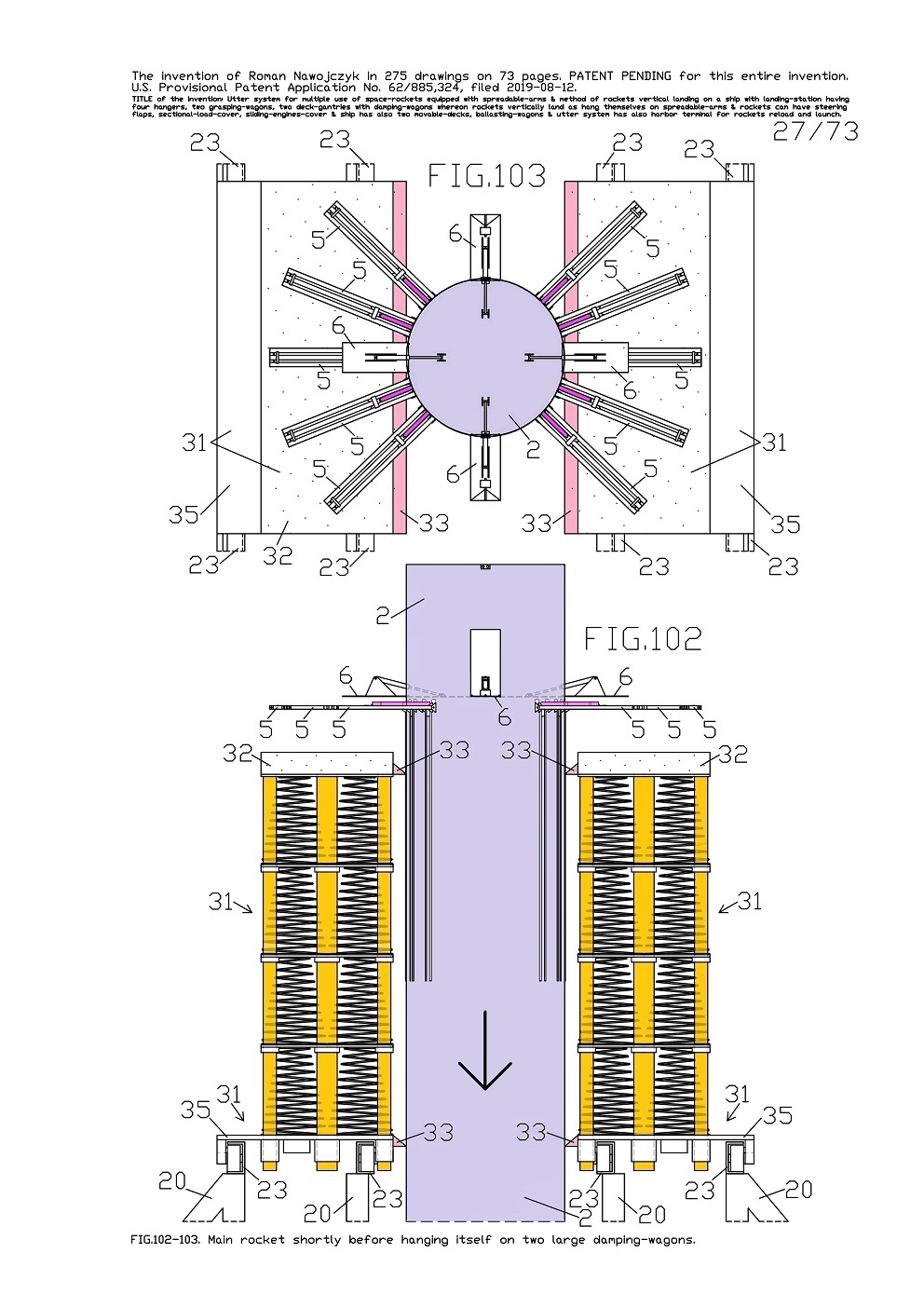
|
FIG.102, 103 show two views of one main-rocket 2 upper part and of two movable ship-gantries 20 upper part whereon tops stand two large damping-wagons 31 and which are not compressed. These views show just vertically landing main-rocket 2 which in a moment will hang up itself on two large damping-wagons 31. This rocket has entirely lifted (spread out) all ten spreadable-arms 5 which do not lay yet on the flexible-layers 32 on these large damping-wagons 31. |
|
Whereat four flaps 6 are entirely deflected outside the rocket frame. On FIG.103 are visible four flexible wedge-shaped-fenders 33 whereon is already leaned against this rocket frame in despite of this rocket does not hang up yet on both large damping-wagons 31. On this FIG.103 is not shown below situated the sliding-engines-cover 7. The current views target showing fitting way of both large damping-wagons 31 with ten spreadable-arms 5 in one main-rocket 2. |

|
FIG.104, 105, 106 show three views of four steering flaps 6 installed in the main-rocket 2 upper part. Currently all four flaps 6 are vertically set and are entirely inside the rocket frame. They are set this way during the rocket ascent toward space. Here the arrows show the deflection out directions of the flaps 6. Whereas FIG.104 is the side view, FIG.105 is the top view, FIG.106 is the front view. All four flaps 6 are in large sizes so that they could steer the rockets even at low speeds of their descent in the Earth's atmosphere. Each space-rocket has installed four steering flaps 6. Two opposite flaps 6 have additionally installed some torsional-triangles 59 which serve for precise steering of entire rocket axial torsion, needed before landing on two movable ship-gantries 20. |
|
FIG.110, 111, 112 show three views of four steering flaps 6 in the main-rocket 2 upper part. Currently all four flaps 6 are entirely deflected outside ergo mainly for aerodynamic braking and steering the rocket at low speed of its descent in the Earth's atmosphere as on FIG.262-267. And FIG.110 is the side view, FIG.111 is the top view, FIG.112 is the front view. . . |

|
FIG.113, 114, 115, 116, 117, 118 show the enlarged views of one steering flap 6 together with the sketches of its deflection mechanism in the main-rocket 2 fragment. |
|
Each flap 6 has permanently fastened two ample-brackets 57 whereto are rotatably installed the linear-actuator 60. The linear-actuator 60 second end is rotatably installed inside the rocket frame. The linear-actuators 60 steer deflections of the entire flaps 6. On upper parts of two opposite flaps 6 are installed rotary-actuators 58 which strongly grasp and steer axial torsion of the torsional-triangles 59. Therewith both torsional-triangles 59 serve for precise steering of entire rocket axial torsion, needed before landing on two movable ship-gantries 20. . |

|
FIG.119, 120, 121 show three views of the fragment of one main-rocket 2 upper part which has entirely lowered all ten spreadable-arms 5 and consequently they are alongside the rocket frame. |
|
FIG.120 shows the moving mechanisms outside and inside rocket. These views show in this rocket interior, arrangement of ten moving mechanisms which spread out the spreadable-arms 5. |

|
FIG.122, 123 show two views of the fragment of one main-rocket 2 upper part which has entirely lifted all ten spreadable-arms 5 and consequently they are completely spread out on two sides. And therefor these spreadable-arms 5 are transverse the rocket frame. Whereas FIG.122 is the side view. And FIG.123 is the top view. |
|
Furthermore is visible in the rocket interior, arrangement of ten moving mechanisms which spread out ten spreadable-arms 5. And is visible in the rocket interior, arrangement of ten large-C-shaped beams 69 wherein inside are the blocking-bars 54 which can be move slidingly and lineally by linear-actuators 70. |

|
FIG.124, 125 show two enlarged views of the fragment of one booster-rocket 1 upper part which has entirely lifted all six spreadable-arms 5 and consequently they are completely spread out on two sides. And therefor these spreadable-arms 5 are transverse the rocket frame. |
|
Furthermore all views show in the rocket interior, arrangement of six moving mechanisms of six spreadable-arms 5. And show in the rocket interior, arrangement of six large-C-shaped beams 69 wherein inside are the blocking-bars 54 which can be move slidingly and lineally by linear-actuators 70. |

|
FIG.126, 127, 128 show three views of one entire spreadable-arm 5 together with its moving mechanism and with one blocking-bar 54 and its pushing mechanism. These views are in the rocket frame fragments with the sub-assemblies outside and inside. This spreadable-arm 5 is entirely lowered to P1 first setting and consequently it is alongside the rocket frame. While, the blocking-bar 54 is inside the rocket frame. |
|
Both lateral-beams 56 bottoms are rotatably joined with the middle-beam 55 top by means of the common-long-axle 65. Between the middle-beam 55 and both lateral-beams 56 on the common-long-axle 65 are inserted two distance-blocks 81. The middle-beam 55 bottom is rotatably joined with the slider 53 by means of the holding-axle 66. The slider 53 can move slidingly between two corner-beams 52 on the rocket frame. To middle-beam 55 is permanently fastened a T-bar 67 and the long-plate 64 for aerodynamic purposes. Inside the middle-beam 55 bottom is installed a frictional-brake 68. |

|
FIG.144, 145, 146 show outside and partly inside the rocket fragment, the three views of one entire spreadable-arm 5 in P2 setting which is in one-quarter lifted and consequently protrudes outside the rocket frame. Whereas FIG.144 is the side view and the partial vertical sectional view of the rocket frame. |
|
Inside the rocket fragment FIG.144 shows all components and moving mechanism of the spreadable-arm 5. |

|
FIG.150, 151, 152, 153 show outside and inside the rocket fragment the views of one entire spreadable-arm 5 in the P6 setting which is entirely lifted and consequently it is transverse the rocket frame. Whereat the blocking-bar 54 is slid maximally outside the rocket frame and it entirely blocked the middle-beam 55 in the spreadable-arm 5. Whereas FIG.150 is the side view with the partial vertical sectional view of the rocket frame. And FIG.151 is the top view and with all components and mechanisms and this view has one auxiliary right-side-view without some drawing number. And FIG.152 is the front view outside the rocket frame.This view in the rocket interior has the sketches of the flat-bars 72 together with both lateral-beams 56 upper bent parts. On the rocket frame are visible two whole corner-beams 52 which lead the slider 53 of the spreadable-arm 5. This view has also the auxiliary bottom projection without some drawing number. On FIG.150 on the rocket frame one large arrow shows the rocket descent direction in the Earth's atmosphere. Whereas the external arrows show from what direction comes flying atmospheric air and consequently in what way this air strongly crowds into the spreadable-arm 5 entirely lifted. |
|
FIG.153 is auxiliary and is the side view and the partial vertical sectional view which shows FIG.152 only in the middle. Namely FIG.153 shows the fragments of the middle-beam 55 and of the slider 53 and furthermore of the blocking-bar 54 fragment. |
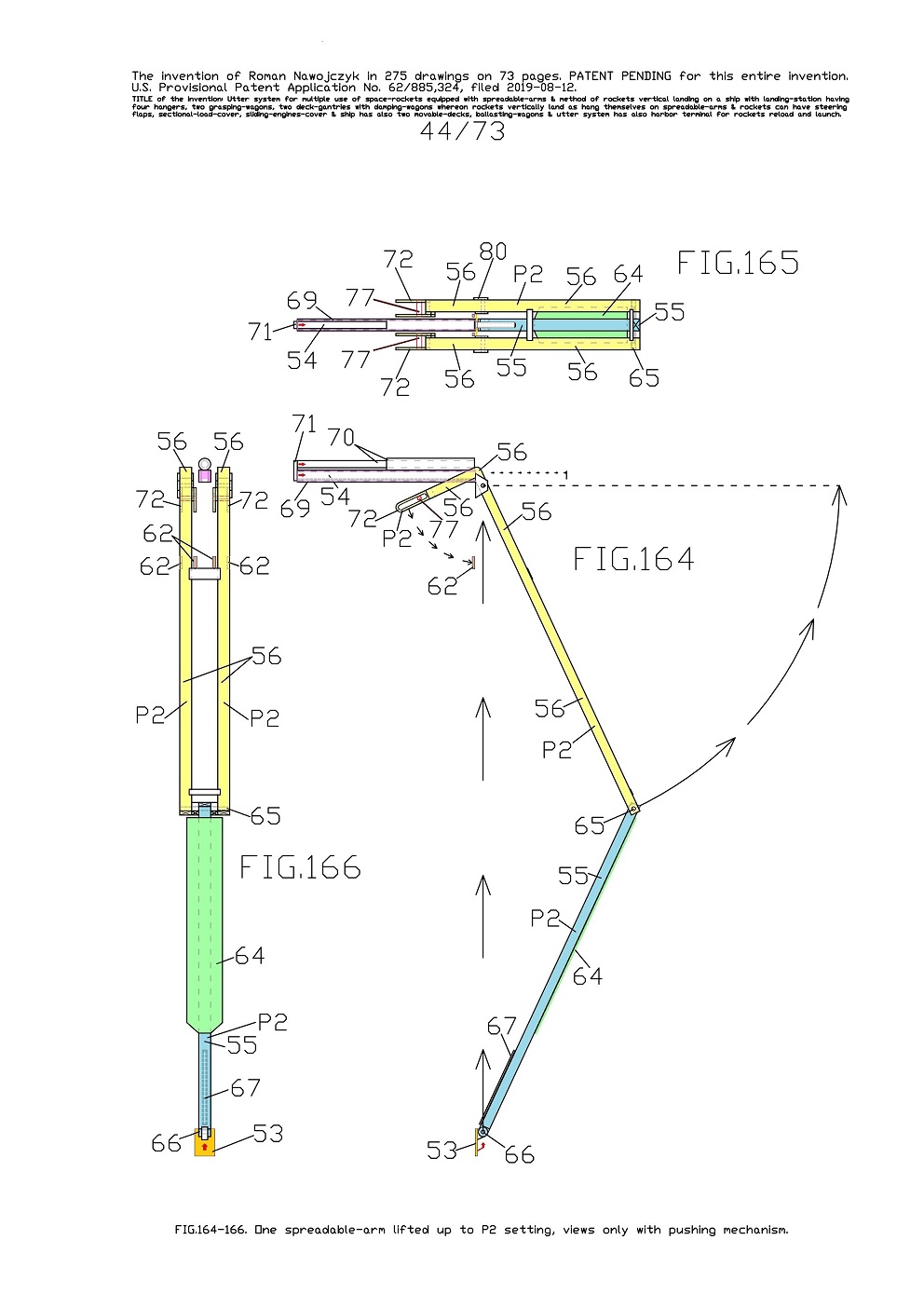
|
FIG.164, 165, 166 show three views of the alone spreadable-arm 5 which is in one-quarter lifted to P2 setting. These views are similar to FIG.144, 145, 146 however do not contain the moving mechanism of this spreadable-arm 5 except of the cylindrical-pegs 77. There are also not the rocket fragments except of four bearing-brackets 80 and four limiters 62. |
|
While, here is also the entire pushing mechanism of the blocking-bar 54 that is not slid outside. |

|
FIG.204, 205, 206, 207 show the views of one sliding-engines-cover 8 which can be lowered and here is in version wedge-shaped underneath after its lowering. This sliding-engines-cover 8 is installed to rocket frame bottom because there are its main engines. All current views show only the booster-rocket 1 bottom. Currently the sliding-engines-cover 8 is entirely lifted and it causes that all main-engines nozzles 85 are entirely uncovered. |
|
Current version, the sliding-engines-cover 8 creates a wedge underneath the rocket after coming to each other and touching on themselves of both jalousies 88. This wedge underneath the rocket entirely cover underneath the rocket main engines. Furthermore both sliding rounded-plates 91 are pointed in some bottom edges so that they adjoin to both jalousies 88. |

|
FIG.208, 209, 210, 211 show the views of the sliding-engines-cover 8 which can be lowered and here is in version wedge-shaped underneath after its lowering. This sliding-engines-cover 8 is installed to rocket frame bottom because there are its main engines. Current views show only the booster-rocket 1 bottom. |
|
The large wedge-shape is the main-cover with jalousies 88 of the rocket main engines whereas this rocket will enter into the Earth's atmosphere.
|

|
FIG.212A, B, 213, 214A, B show the views of the upper and bottom parts of one booster-rocket 1 which descends in the first time period at giant speed in the Earth's atmosphere. |
|
Such arrangement of all components and sub-assemblies of this entire booster-rocket 1 will occur during its descent in the first time period at giant speed in the Earth's atmosphere.
|
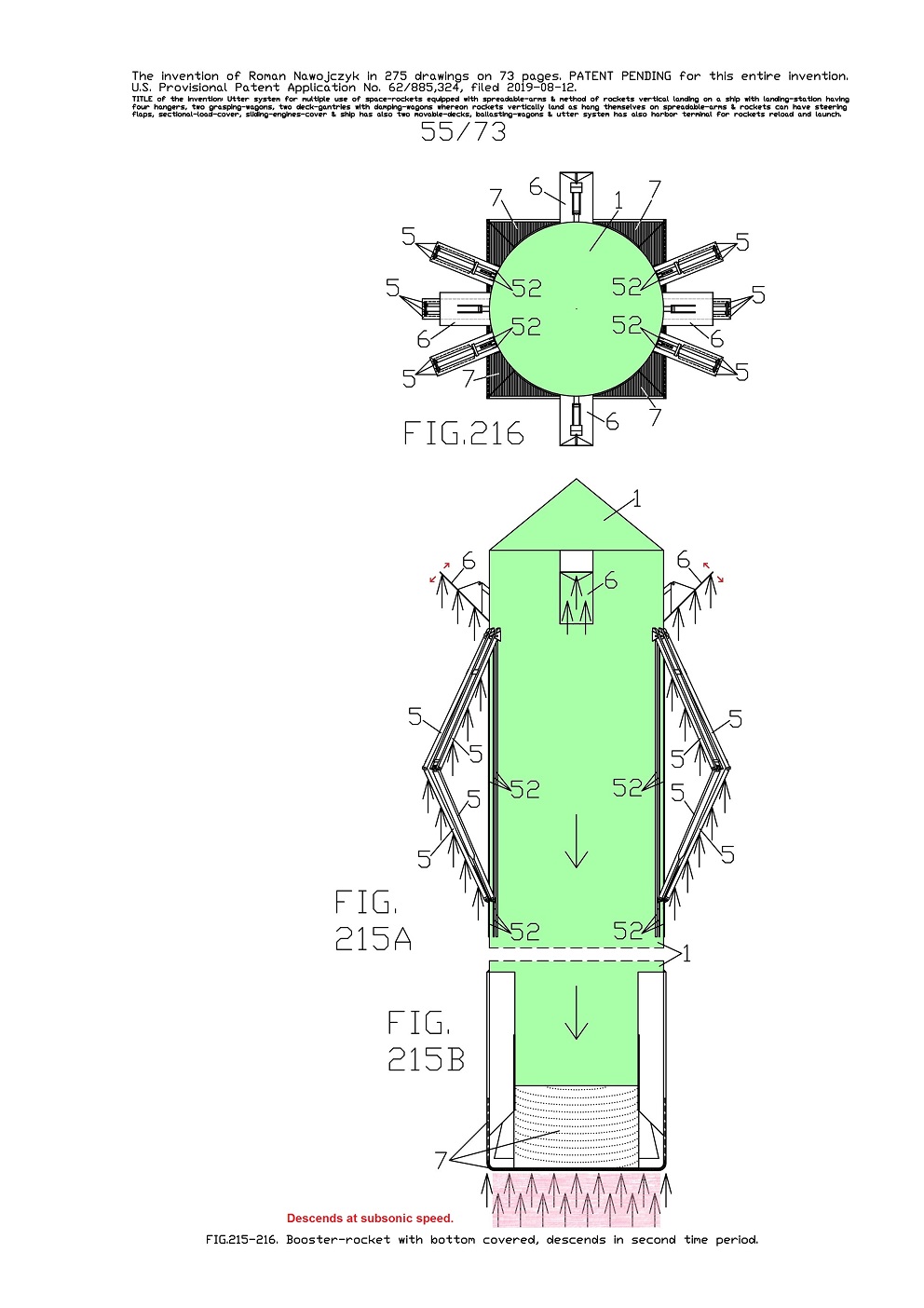
|
FIG.215A, B and 216 show the views of the upper and bottom parts of one booster-rocket 1 which descends at average speed in the Earth's atmosphere. |
|
On FIG.215A, B on the rocket frame, the large arrows show the rocket descent direction in the Earth's atmosphere. |

|
FIG.217, 218, 219, 220 show the views of one entire main-rocket 2 which has installed a sectional-load-cover 4 which is dividable into two sections and spreadable out on two opposite sides. The sectional-load-cover 4 serves for covering inside some load 100 and this way creates its thermal protection during the rocket ascent and descent in the Earth's atmosphere. Thus inside the sectional-load-cover 4 can be fastened some payload that will be carried out on the Earth's orbit and later can be fastened some return-load that will be carried down on Earth. The sectional-load-cover 4 is installed on main-rocket 2 upper part and can be situated above the second-stage-rocket 3. |
|
While, inside the sectional-load-cover 4 is placed a payload 100 which will be carried out on the Earth's orbit. This payload 100 is attached to second-stage-rocket 3. |

|
FIG.225, 226 show the enlarged views of the main-rocket 2 upper part shown also earlier on similar FIG.223-224. Currently the sectional-load-cover 4 is lifted maximally upward on four long cog-beams 93. This enables spreading it out on two sides. Here is visible vacant space between the sectional-load-cover 4 bottom edge and the second-stage-rocket 3 upper edge. |
|
This vacant space is visible on the current views and is indicated with the large exclamatory sign. In this vacant space is already directly visible the fragment of the payload 100 that will be carried out on the Earth's orbit. The information that was not included in the patent application. |
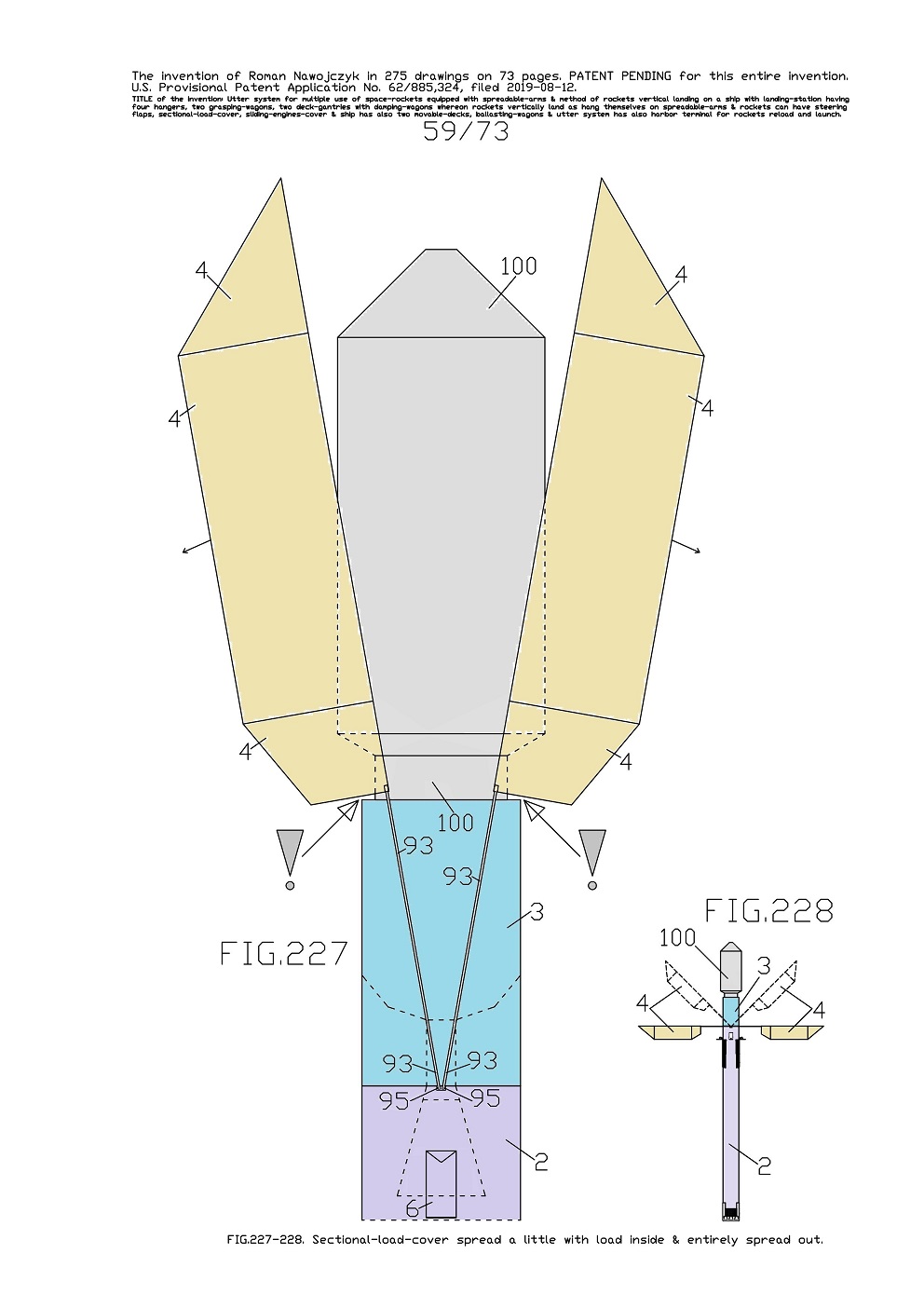
|
FIG.227 shows enlarged side view of the main-rocket 2 upper part shown earlier on similar FIG.223, 225. Here the sectional-load-cover 4 is already spread a little out on two sides. It is possible because there is vacant space between the sectional-load-cover 4 bottom edge and the second-stage-rocket 3 upper edge. This vacant space is visible on the current view and is indicated with two large exclamation marks. |
|
All rotating-axles 95 became rotated tiny angle and it rotated the same tiny angle all entire cog-beams 93 and with them also both sections of the sectional-load-cover 4. |
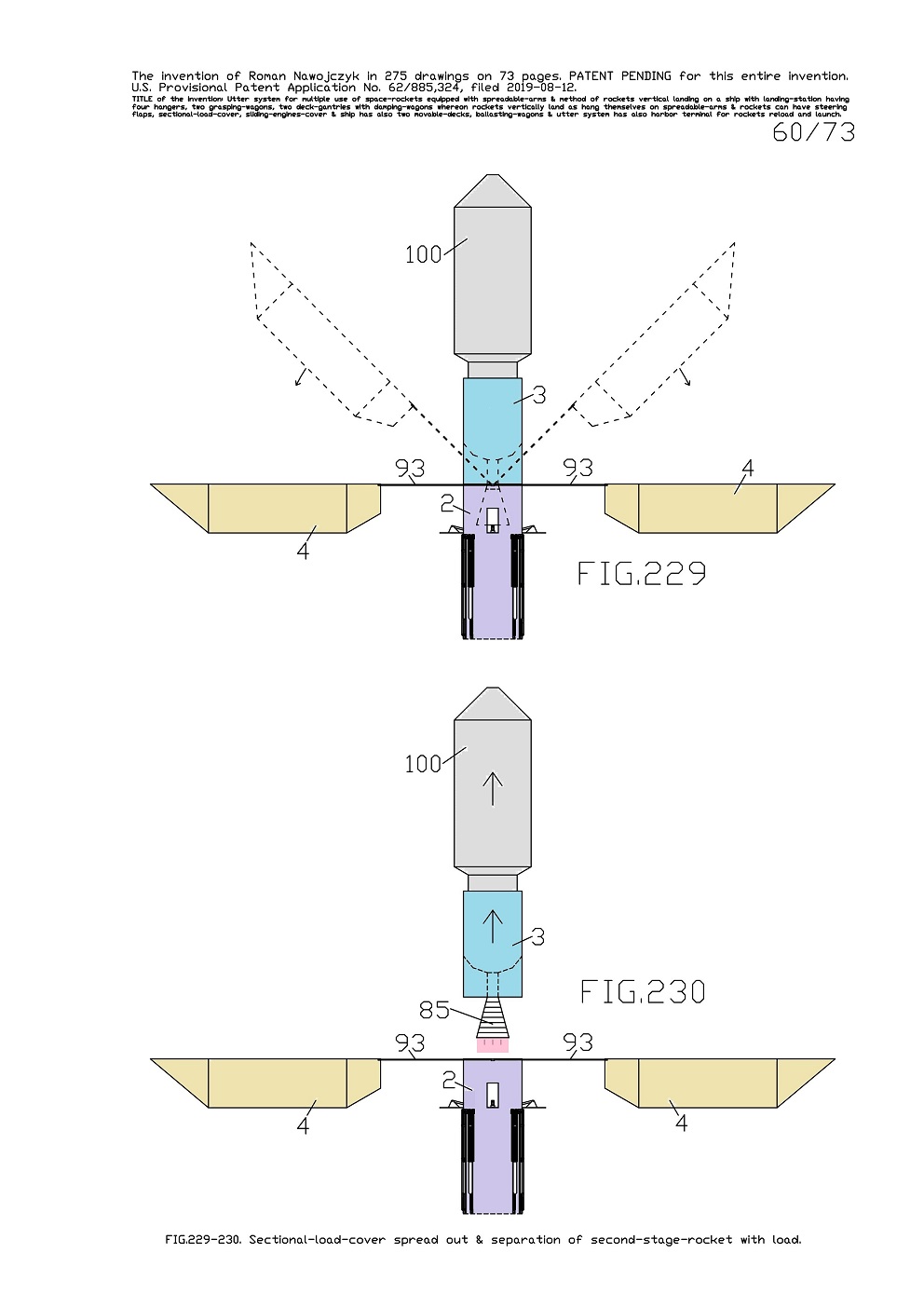
|
FIG.229 shows the side view of the main-rocket 2 upper part which has entirely spread out on two sides the sectional-load-cover 4 and the sketch its intermediate spreading out. Because of total spreading out on two sides the sectional-load-cover 4, there is entirely uncovered the payload 100 which is attached to second-stage-rocket 3. |
|
FIG.230 shows the side view of the main-rocket 2 upper part which has also entirely spread out the sectional-load-cover 4. And here the second-stage-rocket 3 with attached payload 100 ascend together upward because they already separated from the main-rocket 2. |

|
FIG.231 shows the side view of the main-rocket 2 upper part which has entirely spread out on two sides the sectional-load-cover 4. Here the second-stage-rocket 3 with attached a return-load 106 approach together to main-rocket 2 in order to dock with it. The second-stage-rocket 3 has the nozzle 85 which is folded for more safely docking. |
|
FIG.232 shows the side view of the main-rocket 2 upper part whereto is already docked the second-stage-rocket 3 with attached the return-load 106. Here the sectional-load-cover 4 is already a little shut up. |

|
FIG.233, 234, 235, 236 show the views of the alone main-rocket 2 upper part ergo without docked the second-stage-rocket 3. |
|
Simultaneously it is visible that the cog-beams 93 are rotatably installed to main-rocket 2 frame. And here is clearly visible emplacement of four uncovered hoisting-gears 96 of the sectional-load-cover 4 both sections. . |

|
FIG.237-243 show the views of the alone main-rocket 2 upper part ergo without docked the second-stage-rocket 3. |
|
And FIG.240, 241 show the side view and the front view of the main-rocket 2 upper part which has also the entirely shut up sectional-load-cover 4. This sectional-load-cover 4 is already lowered a lot on four cog-beams 93. After lowering the sectional-load-cover 4, four cog-beams 93 upper ends entered a lot inwards this sectional-load-cover 4. Here the arrows under the sectional-load-cover 4 show the direction its further lowering to main-rocket 2. . |

|
FIG.256, 257, 258, 259 show the views of the entire main-rocket 2 which is attached in two variants with a payload-module 103 and a crew-module 102 and which were not shown on any earlier views. The payload-module 103 has two gates with cargo bay while, the crew-module 102 has some windows. |
|
And FIG.258 is the side view, FIG.259 is the front view. Such attaching variant will be applied while, on the Earth's orbit this assemblage will not separate from the main-rocket 2. Consequently here is not the second-stage-rocket 3. |

|
FIG.262-267 show examples of descending in the Earth's atmosphere of one booster-rocket 1 and of the main-rocket 2 with on its top mounted various assemblages and in various variants. These rockets descend in the Earth's atmosphere during the third so the last time period at slow speeds and therefor all rockets could already entirely lift upward their all spreadable-arms 5 and entirely deflected out their all steering flaps 6. Moreover all rockets still have totally shut down their sliding-engines-cover 7. On all rocket-frames the large arrows show their descent direction in the atmosphere. Whereat the external arrows show from what direction come flying atmospheric air. Therefore these arrows show in what way the air strongly crowds into all sub-assemblies, sections, assemblages and modules of these space-rockets. |
|
Whereas FIG.266 shows the side view of one main-rocket 2 which has also entirely lifted (spread out) all ten spreadable-arms 5. This view shows the attaching variant wherein on the main-rocket 2 top is mounted the assemblage that consist of the second-stage-rocket 3 with attached the sectional-load-cover 4. Here is visible that all cog-beams 93 are outside and on both sides of the second-stage-rocket 3.
|
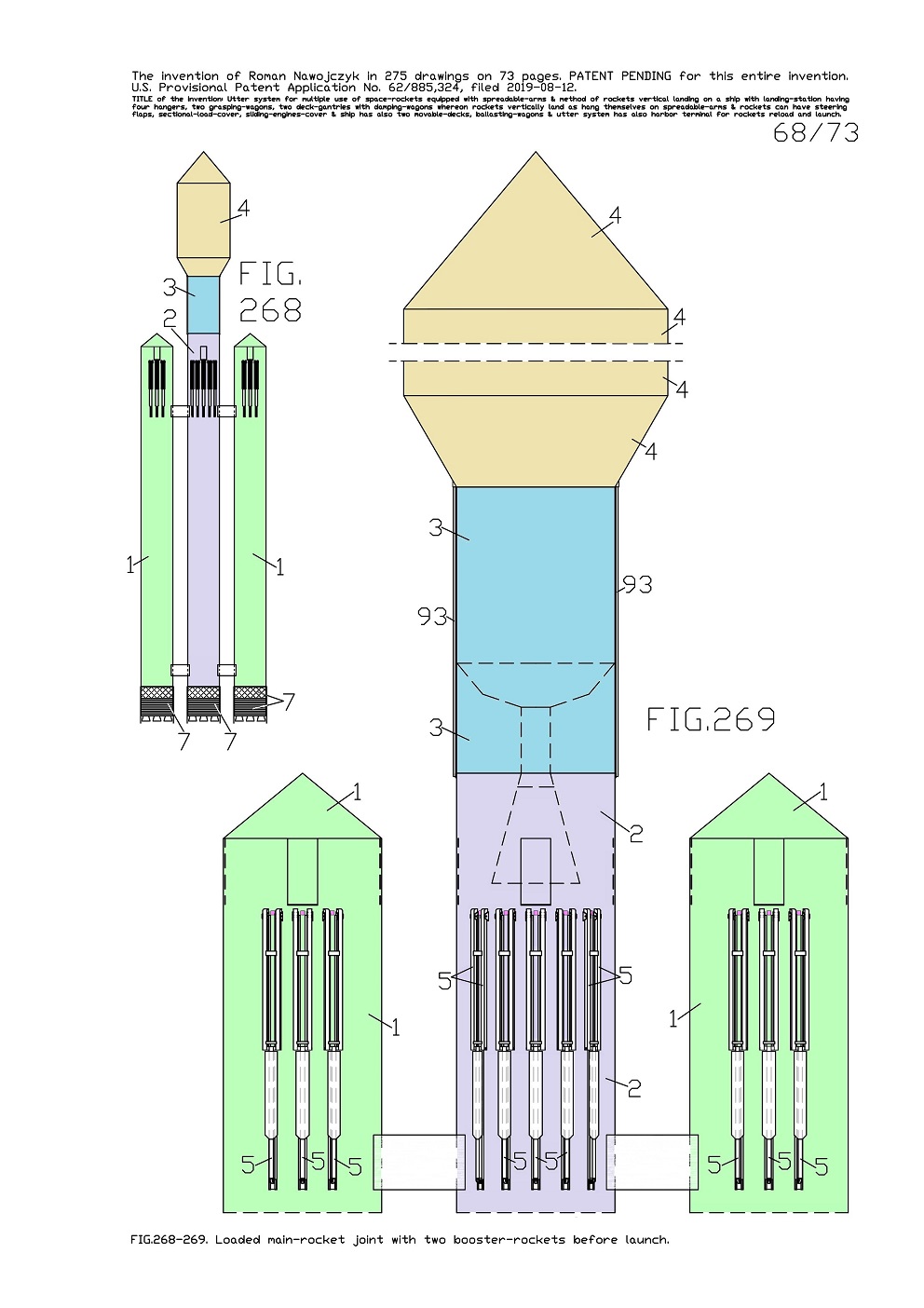
|
FIG.268, 269 show the front views of one main-rocket 2 which is joined on both sides with two booster-rockets 1. |
|
Whereat the sectional-load-cover 4 is directly attached to second-stage-rocket 3 and is attached to main-rocket 2 by means of the cog-beams 93. |

|
FIG.273 is prospectus presentation which shows for example several drawing statuses of one main-rocket 2 which lifted-off and its further traveling trajectory while, unexpectedly happened failure of some main engine. |
|
Thereafter all rocket statuses are in the side drawings and show the main-rocket 2 travel toward the specific sea ship 10. |

|
The views on FIG.274, 275 show for example one booster-rocket 1 which slips by through the wide-opened interior of the specific sea ship 10 at open sea. And FIG.274 is the side view, FIG.275 is the top view. |
|
As result, inside the specific sea ship 10 multi-hull arose the giant open interior where-into is only sea surface. Accurately into this giant open interior struck hard this booster-rocket 1 and plunged in sea-water. . |
THE END